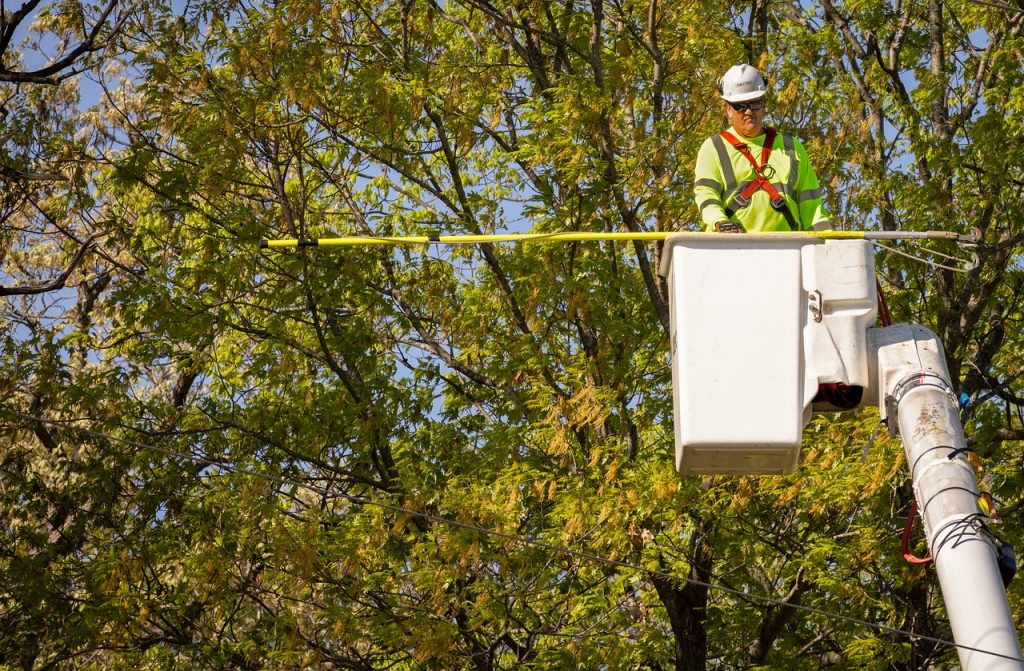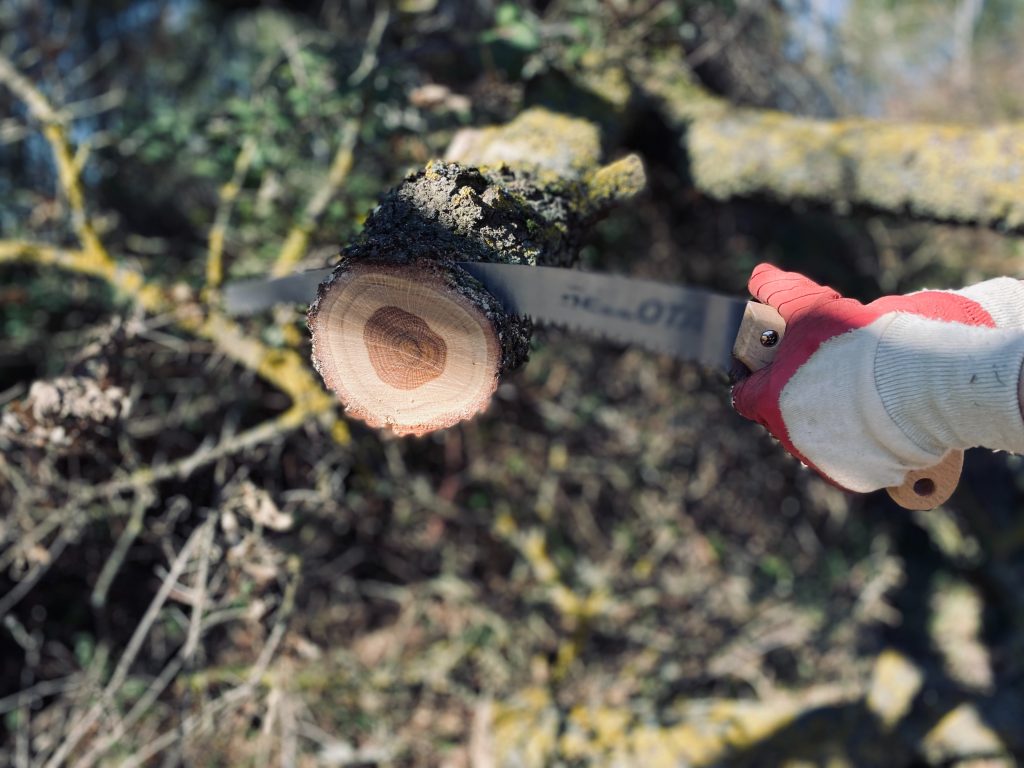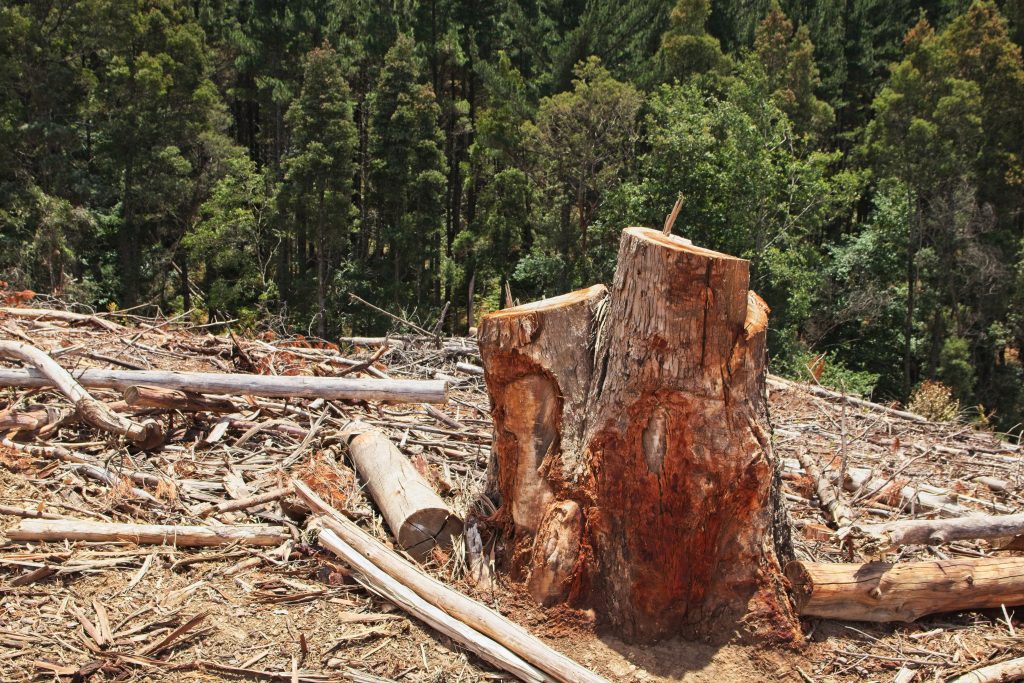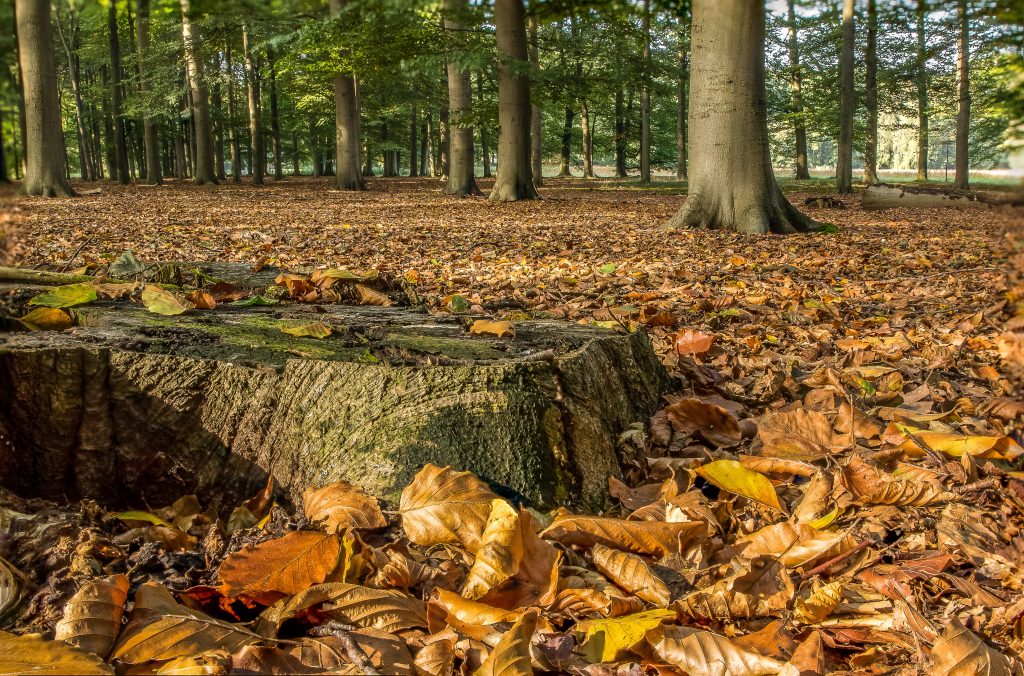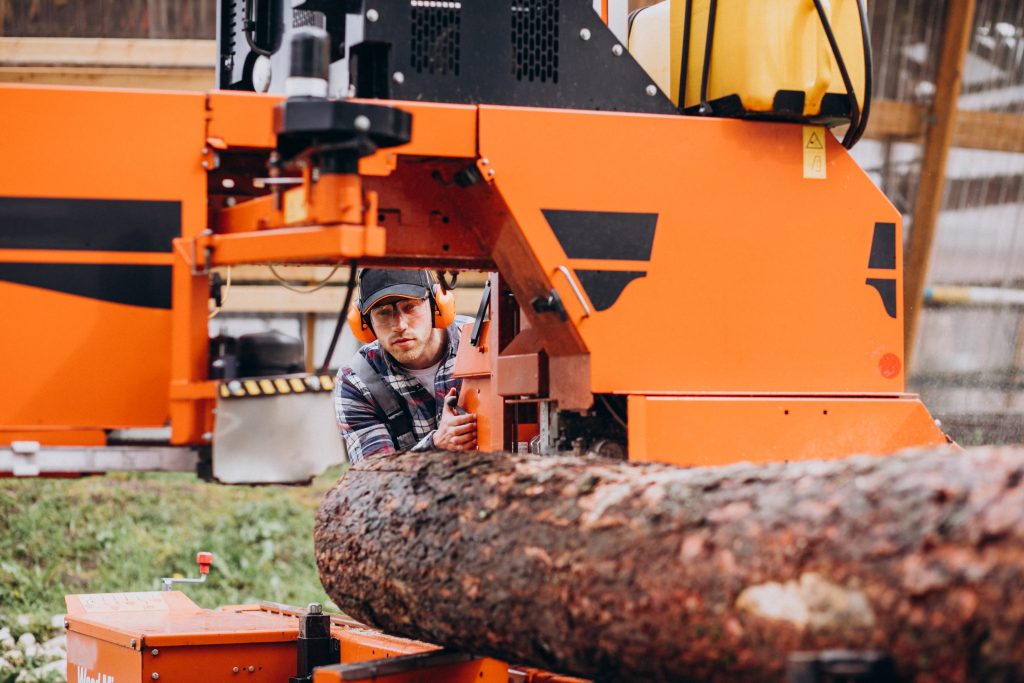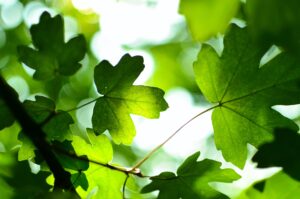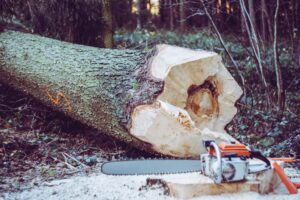What Kind of Damage Does Tree Removal Cause to the Lawn?
What Kind of Damage Does Tree Removal Cause to the Lawn?
Are you wondering what havoc tree removal can wreak on your pristine lawn? Well, fear not, my friend, for we are about to embark on a journey of knowledge and understanding. In this article, we will explore the environmental impact of tree removal and uncover the secrets of maintaining a healthy lawn amidst the chaos. With a plethora of tips, traits, and step-by-step instructions, you’ll be equipped to navigate the treacherous waters of tree removal with confidence. So, grab your gardening gloves and let’s dive in!
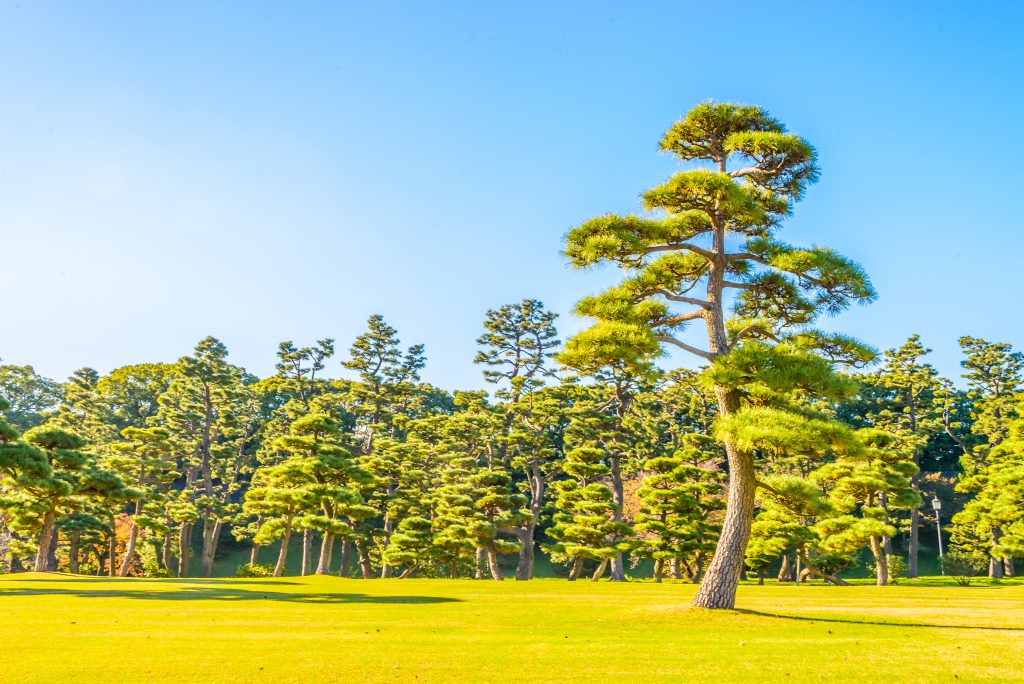
Key Takeaways
- Loss of habitat for wildlife
- Soil erosion and degradation
- Disruption of climate regulation
- Disrupts ecosystems and affects surrounding landscape
Introduction: Environmental Impact
Tree removal can have a significant impact on the environment, including the loss of habitat for wildlife. When trees are removed, it disrupts the delicate balance of the ecosystem and can lead to several negative consequences. Here are some key points to consider regarding the environmental impact of tree removal:
- Loss of habitat: Trees provide shelter and nesting sites for various species of wildlife. Removing them can leave animals without a place to live and breed, leading to a decline in their populations.
- Soil erosion: Tree roots help hold the soil in place, preventing erosion. Without trees, rainwater can easily wash away the topsoil, causing degradation and loss of fertile land.
- Air quality: Trees play a vital role in purifying the air by absorbing pollutants and releasing oxygen. Removing trees reduces the natural filtration system, leading to decreased air quality.
- Climate regulation: Trees help regulate temperature and moisture levels in the environment. They provide shade, reduce the heat island effect, and contribute to rainfall patterns. Removing trees disrupts these natural processes, affecting the overall climate.
To mitigate the negative effects of tree removal, it is crucial to prioritize environmental preservation and adopt sustainable practices. These include planting new trees to replace the ones that are removed, practicing responsible logging techniques, and promoting the use of alternative materials to reduce the demand for wood. By implementing these measures, we can minimize the environmental impact of tree removal and ensure a sustainable future.
Transitioning into the subsequent section about the ‘history of tree removal,’ it is important to understand the context and evolution of tree removal practices to appreciate the significance of environmental preservation today.
History of Tree Removal
When you remove a tree from your property, you might not be aware of the historical significance it holds. The history of deforestation dates back centuries, with humans actively removing trees for various purposes. In ancient times, trees were cleared to make way for agriculture and settlements. As civilizations grew, so did the demand for wood, leading to extensive deforestation. Techniques for tree removal varied depending on the time and region. In earlier times, trees were often cut down using simple tools like axes and saws. However, as technology advanced, more efficient methods emerged. Today, we have access to powerful machinery like chainsaws and cranes that make the process quicker and easier. It is important to understand the historical context of tree removal, as it helps us appreciate the value of our trees and the impact their removal can have on the environment. Now, let’s delve into some tips on how to minimize the damage caused by tree removal.
Tips
When it comes to maintaining a healthy lawn, it’s important to be aware of the potential effects of soil compaction, changes in sunlight availability, and the risk of nutrient depletion. Soil compaction can lead to reduced water and air circulation, hindering root growth and nutrient absorption. Additionally, the removal of trees can result in increased sunlight exposure, altering the microclimate and potentially affecting the growth of certain plants. Furthermore, the process of tree removal can disrupt the balance of nutrients in the soil, requiring additional fertilization and care to prevent nutrient depletion. Being knowledgeable about these factors will help you make informed decisions and take appropriate steps to maintain the health and vitality of your lawn.
Soil Compaction Effects
To prevent soil compaction effects caused by tree removal, you should avoid heavy machinery on your lawn. The use of heavy machinery can lead to the compression and displacement of soil particles, which can have long-lasting negative effects on the health of your lawn. Instead, opt for manual methods of tree removal, such as hand digging or using small tools. By minimizing the use of heavy machinery, you can minimize the damage to the soil structure and preserve its ability to absorb water and nutrients.

If soil compaction has already occurred due to tree removal, there are restoration techniques that can help improve the soil condition. Aeration is one such technique that involves creating small holes in the soil to loosen it up and enhance its ability to absorb water and nutrients. Adding organic matter, such as compost or mulch, can also help improve the soil structure and fertility.
With soil compaction effects minimized and restoration techniques implemented, the next concern is the changes in sunlight availability caused by tree removal.
Sunlight Availability Changes
After removing trees, sunlight availability in the area may be affected. The shade provided by trees is often a key factor in determining the amount of sunlight that reaches the lawn. When trees are removed, the once shaded areas are exposed to direct sunlight, while surrounding areas may still receive shade from neighboring trees. This change in sunlight availability can have a significant impact on the lawn, as certain grass varieties may struggle to thrive in full sun or may become more susceptible to heat stress. To address this issue, lawn restoration techniques such as overseeding with shade-tolerant grass species or planting new trees can help mitigate the negative effects of reduced sunlight. However, it is important to carefully evaluate the specific needs of your lawn and consult with a professional for the best course of action to restore sunlight availability and promote healthy growth. Moving on to the next topic, the removal of trees can also lead to nutrient depletion risks for the lawn.
Nutrient Depletion Risks
Now that you understand the changes in sunlight availability caused by tree removal, it’s important to consider the long-term effects on nutrient depletion. When trees are removed from your lawn, they take away a significant source of organic material that contributes to soil fertility. As trees shed leaves and branches, they naturally replenish the soil with essential nutrients. However, with their removal, the nutrient cycle is disrupted, leading to potential deficiencies in your lawn. Over time, this can result in weakened grass, decreased resilience to stressors, and increased susceptibility to diseases and pests.
To mitigate these risks, it’s crucial to prioritize nutrient replenishment in your lawn care routine. Regularly apply fertilizers that contain the necessary nutrients, such as nitrogen, phosphorus, and potassium. Additionally, consider adding organic matter, such as compost or mulch, to enhance soil fertility. By taking these steps, you can help maintain a healthy, vibrant lawn even after tree removal.
Moving forward, let’s delve into the traits and characteristics of trees that can impact your lawn.
Traits and Characteristics
You’ll notice that tree removal can result in bare patches and soil compaction on your lawn. However, it is important to understand the traits and characteristics of this process, as well as how it can promote tree replanting. When a tree is removed, the roots are also taken out, leaving behind empty spaces in the soil. These bare patches not only disrupt the overall aesthetics of your lawn, but they also create an opportunity for weeds to take over. Additionally, the heavy machinery used for tree removal can cause soil compaction, making it difficult for new plants to establish their roots.
Promoting tree replanting is crucial in mitigating the damage caused by tree removal. By replacing the removed tree with a new one, you can help restore the balance and beauty of your lawn. When choosing a tree to replant, consider its size, growth rate, and compatibility with your soil type and climate. This will ensure that the new tree can thrive and provide the same benefits as the previous one.
Transitioning into the subsequent section about steps for proper tree removal, it is important to take certain precautions to minimize the negative impacts on your lawn. By following these guidelines, you can ensure that the tree removal process is done in a way that minimizes damage and allows for successful replanting.
Steps for Proper Tree Removal
To properly remove a tree, it’s important to follow these steps to ensure minimal impact on your lawn. Taking the right approach will not only make the process smoother but also protect the health and beauty of your landscape. Here are the key steps for proper tree removal:

- Assess the tree: Begin by evaluating the tree’s condition and size. Determine if it poses any risk or if it’s healthy but simply in an inconvenient location.
- Plan the removal: Develop a strategy for safely removing the tree. Consider factors such as the tree’s proximity to structures or power lines, as well as the equipment and manpower needed.
- Obtaining permits: Check if you need any permits or permissions from local authorities before proceeding with the removal.
- Hire a professional: Engage a certified arborist or tree removal service with the expertise and equipment necessary for the job.
Goals
When removing a tree, your main objectives should be to ensure safety, preserve the surrounding environment, and maintain the aesthetic appeal of your landscape. Safety is crucial, as improper tree removal can lead to accidents and property damage. Preserving the surrounding environment is important to maintain the balance of the ecosystem and protect the natural habitat. Lastly, maintaining the aesthetic appeal of your landscape ensures that your property remains visually appealing.
To better understand the impact of tree removal on your lawn, let’s take a look at the following table:
| Damage Caused by Tree Removal | Emotional Impact | Solution |
|---|---|---|
| Reduced sunlight exposure | Frustration | Plant shade-tolerant plants |
| Disrupted root system | Loss | Replant trees or apply mulch |
Reduced sunlight exposure can be frustrating, as it may affect the growth of plants and grass in your lawn. To mitigate this, consider planting shade-tolerant plants that can thrive with less direct sunlight. On the other hand, a disrupted root system can cause a sense of loss, as it takes away the stability and nourishment the tree provided. To address this, you can either replant trees in the area or apply mulch to help the soil retain moisture and provide nutrients to other plants.
Understanding the potential damage caused by tree removal allows you to take appropriate actions to mitigate its effects. Now, let’s explore habits for sustainable tree removal without compromising the health of your lawn.
Habits for Sustainable Tree Removal
Now that you understand the goals of tree preservation, let’s dive into some habits for sustainable tree removal. When it comes to tree removal, it’s important to consider eco-friendly techniques that minimize damage to the environment. By incorporating these habits into your tree removal practices, you can help preserve the health and beauty of your lawn.
One important habit is to hire a professional arborist who specializes in eco-friendly tree removal techniques. These experts have the knowledge and experience to safely remove trees while minimizing the impact on the surrounding environment. They can use methods like low-impact rigging, which involves carefully lowering tree limbs to the ground instead of letting them crash down. This helps prevent damage to the lawn and other plants.
Another habit is to properly dispose of tree debris. Instead of burning or sending it to a landfill, consider recycling or reusing the wood. Wood chips can be used as mulch or composted, while larger pieces can be repurposed for furniture or crafts.
A Real-Life Story
You can learn from this real-life story that highlights the importance of incorporating sustainable tree removal practices to protect the environment. In a small suburban neighborhood, a homeowner decided to remove a large tree from their front yard. Without considering the potential environmental impact, they hired a company that used heavy machinery to uproot the tree, leaving behind a barren patch of soil. As a result, the surrounding ecosystem suffered greatly. Birds lost their nesting site, insects lost their habitat, and the soil eroded, affecting the overall health of the lawn. This real-life experience serves as a powerful reminder of the need for environmentally-conscious tree removal practices. By utilizing methods such as tree pruning, selective cutting, and replanting, we can minimize the negative impact on the surrounding environment. These practices help preserve the natural balance, maintain biodiversity, and ensure the long-term health of our ecosystems. So, when it comes to tree removal, always consider the bigger picture and choose sustainable methods that prioritize environmental preservation.
Now, let’s delve into the insights and wisdom shared by experts in the field through their quotes.
Quotes
Listen to the experts, they’ve shared valuable insights and wisdom about sustainable tree removal practices. When it comes to removing a tree from your lawn, it’s important to consider the potential damage it may cause. One of the key factors to keep in mind is the effect on sunlight. Trees provide shade, and their removal can result in increased exposure of your lawn to sunlight. This can lead to several consequences, including increased evaporation of moisture, which may cause your lawn to dry out faster and become more susceptible to heat stress. Moreover, excessive sunlight can also affect the growth of grass and plants, leading to patchy and uneven areas on your lawn.
Another factor to consider is nutrient depletion. Trees play a crucial role in cycling nutrients in the ecosystem. When a tree is removed, the nutrients it once absorbed from the soil are no longer being replenished. This can result in nutrient depletion, negatively impacting the health and vitality of your lawn. It’s important to address this issue by implementing proper fertilization techniques and ensuring that your lawn receives the necessary nutrients to thrive.
Understanding the potential effects of tree removal on your lawn is essential in maintaining its health and appearance. By considering factors such as sunlight effects and nutrient depletion, you can make informed decisions and take the necessary steps to mitigate any potential damage. Now let’s dive into some secrets for successful lawn maintenance without skipping a beat.
Secrets
Understanding the effects of tree removal on your lawn is crucial for maintaining its health and appearance. When it comes to tree removal, there are secrets revealed and hidden dangers that you need to be aware of. One of the secrets is that tree removal can cause significant damage to your lawn. The heavy machinery used to remove trees can compact the soil, making it difficult for grass and other plants to grow. Additionally, the process of removing tree stumps can leave behind large holes in your lawn, which can become hazards if not properly filled and leveled.
Moreover, the roots of the tree that was removed can continue to grow underground, causing further damage to your lawn. These hidden dangers can lead to uneven terrain, bare patches, and an overall unhealthy appearance for your lawn. It is important to address these issues promptly to prevent further damage and restore the health and beauty of your lawn.
Now that you have learned about the secrets and hidden dangers of tree removal on your lawn, let’s delve into some insights on the environmental impact of this process.
Insights on Environmental Impact
Now that we’ve explored the secrets and hidden dangers of tree removal, let’s delve into the environmental impact of this process. Tree removal, when not done properly, can have significant long-term ecological effects. When trees are removed, it disrupts the delicate balance of ecosystems, affecting not only the area around the tree but also the surrounding landscape. Trees play a crucial role in promoting tree conservation by providing habitat for wildlife, improving air quality, and preventing soil erosion.
The removal of trees can lead to a loss of biodiversity as many species depend on trees for food, shelter, and nesting sites. Additionally, trees absorb carbon dioxide and release oxygen, helping to mitigate climate change. The removal of trees can result in an increase in greenhouse gases, contributing to global warming.
Furthermore, tree removal can cause soil erosion and degradation. Without trees to anchor the soil, heavy rain can wash away topsoil, leading to decreased fertility and increased runoff. This can have a detrimental effect on water quality and the overall health of the ecosystem.
Considering the long-term ecological effects of tree removal, it is essential to prioritize sustainable practices that ensure the preservation of trees whenever possible. Sustainable tree removal methods, such as replanting, can help mitigate the environmental impact and promote the long-term health of our ecosystems.
Benefits of Sustainable Tree Removal
When properly executed, sustainable tree removal can have numerous benefits for both you and the environment. Sustainable tree management practices aim to minimize the negative impact on the ecosystem while effectively removing trees that may pose a risk or interfere with other aspects of your property. By employing these practices, you can ensure the conservation of your landscape and contribute to the overall health of the environment.
One of the primary conservation benefits of sustainable tree removal is the preservation of biodiversity. Removing invasive or diseased trees can prevent the spread of harmful pests and diseases to other healthy trees in the area. This helps protect the overall ecosystem and maintains the balance of native flora and fauna.
Additionally, sustainable tree removal can improve the overall health and aesthetics of your property. By strategically removing trees that obstruct sunlight or impede the growth of other plants, you can create a more vibrant and diverse landscape. This can enhance the curb appeal of your property and provide a healthier environment for other plants to thrive.
Lessons
When it comes to dealing with the aftermath of tree removal, there are a few key points to keep in mind. First, you’ll want to consider the impact on your lawn. Tree removal often leaves behind a patch of bare soil that can be unsightly and prone to erosion. Additionally, the process of removing a tree can lead to soil compaction, which can negatively affect the health of your remaining plants. Finally, it’s important to think about replanting and restoration efforts to ensure that your lawn regains its beauty and vitality.
Lawn After Tree Removal
After tree removal, your lawn may experience some damage due to heavy machinery and the removal process. One of the main concerns is the reduced sunlight exposure that your lawn will receive. With the absence of the tree, the area that was once shaded will now be exposed to direct sunlight. This sudden change in light conditions can cause stress to the grass and other plants in your lawn, leading to potential discoloration and even death of some plants.
Furthermore, the root system of the tree plays a crucial role in maintaining the health of your lawn. When the tree is removed, its roots are also uprooted, which can disrupt the stability of the soil. This can result in uneven terrain and potential tripping hazards. Additionally, the removal of the root system can affect the moisture balance in the soil, leading to dry patches and increased soil erosion.
Considering these concerns, it is important to address the damage caused by tree removal promptly. Next, let’s explore the soil compaction concerns that can arise in the aftermath of tree removal.
Soil Compaction Concerns
To address soil compaction concerns, you’ll need to assess the level of compaction in your lawn and take appropriate measures to alleviate it. Soil compaction occurs when the soil particles are pressed together, reducing pore space and making it difficult for water, air, and roots to penetrate. This can minimize the damage caused by tree removal and aid in the process of lawn restoration. Start by inspecting the soil for signs of compaction, such as water pooling or poor drainage. Then, consider aerating the lawn to loosen the soil and improve its structure. Aerating involves creating small holes in the soil to allow for better water and air movement. By taking these steps to address soil compaction, you’ll create an optimal environment for replanting and restoration to take place seamlessly.
Replanting and Restoration
Now that you understand the soil compaction concerns caused by tree removal, let’s discuss the replanting and restoration challenges you may face. Replanting trees in a lawn that has experienced tree removal can be quite a task. The compacted soil makes it difficult for new roots to penetrate and establish themselves. Additionally, the loss of shade from the removed trees can lead to increased evaporation and sun exposure, making it harder for young saplings to thrive.
To overcome these challenges, various restoration techniques can be employed. One common approach is to aerate the soil to alleviate compaction and improve drainage. Adding organic matter, such as compost, can also enhance soil structure and fertility. It’s important to select tree species that are well-suited to your climate and soil conditions. Proper watering and mulching techniques are crucial for the establishment and growth of the new trees.
With these replanting and restoration techniques in mind, let’s move on to discussing routines for maintaining a healthy lawn in the absence of trees.
Routines
During tree removal, it’s important to establish routines to minimize damage to the lawn. Developing good habits for sustainable tree removal not only protects your lawn but also ensures the safety of everyone involved. The first routine to establish is creating a clear plan before starting the tree removal process. Assess the tree’s condition, determine the best approach, and identify any potential risks or obstacles. This will help you anticipate any potential damage to the lawn and take necessary precautions.
Next, make sure to use proper equipment and techniques during tree removal. This includes using ropes and harnesses to control the direction of the tree’s fall, as well as specialized tools that minimize the impact on the surrounding area. By employing efficient and precise cutting methods, you can reduce the chances of branches or debris causing significant damage to the lawn.
Additionally, implementing a routine for post-removal cleanup is crucial. Clearing the area of fallen branches, leaves, and other debris will not only restore the appearance of your lawn but also eliminate potential tripping hazards. It’s also important to inspect the lawn for any damage caused during the tree removal process. If necessary, reseed or replant affected areas to promote healthy growth and restoration.
Establishing these routines and habits for sustainable tree removal will help minimize damage to your lawn and surrounding landscape. By being proactive and taking the necessary steps to protect your lawn, you can ensure a successful tree removal process.
Transitioning into the subsequent section about the pros and cons of tree removal, it’s important to weigh the benefits of removing a tree against the potential drawbacks.
Pros and Cons
Weighing the benefits and drawbacks of tree removal can help determine if it is the right decision for your property. When considering tree removal, it is important to evaluate the pros and cons to make an informed choice. On the positive side, removing a tree can enhance the aesthetic appeal of your property, allowing for better landscaping and more sunlight. It also eliminates any potential hazards that a diseased or damaged tree may pose, reducing the risk of property damage or personal injury. However, there are also cons to consider. Tree removal can disrupt the natural ecosystem, impacting wildlife habitats and reducing biodiversity. It can also lead to soil erosion and decreased air quality. To minimize the ecological impact, it is crucial to replant trees or incorporate other green alternatives. By carefully weighing the pros and cons and taking steps to mitigate any negative effects, you can make a decision that is right for your property and the environment. Now, let’s move on to the dos and don’ts of tree removal to ensure a smooth process.
Dos and Dont’s
It’s important to follow these dos and don’ts when considering the removal of a tree from your property. By following these habits for sustainable tree removal, you can minimize damage to your lawn and ensure a smooth process.
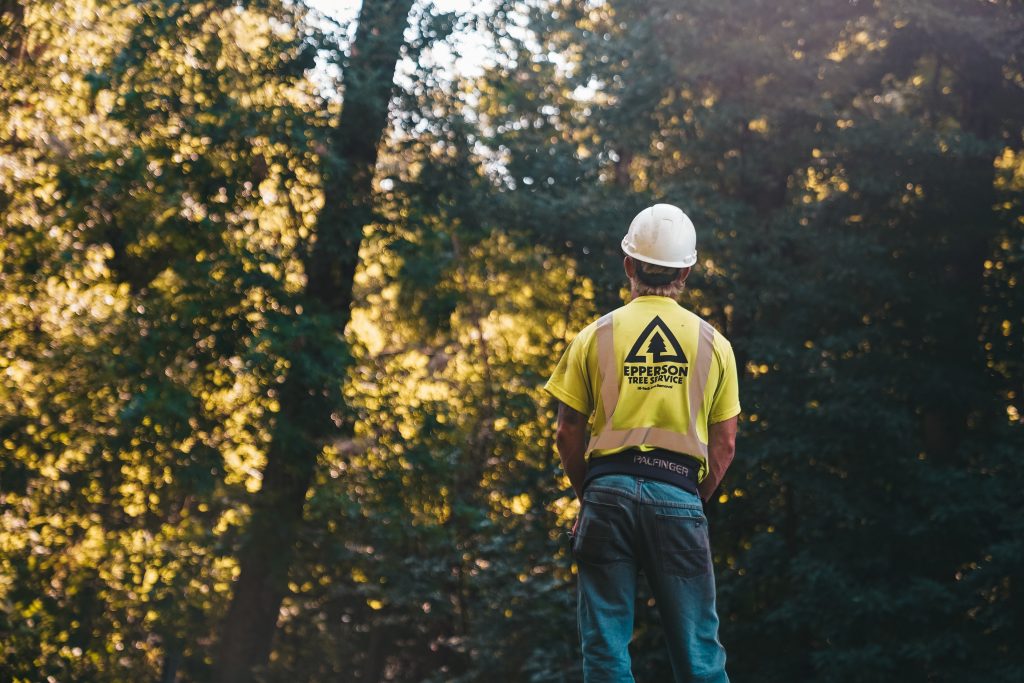
Here are some dos and don’ts to keep in mind:
| Dos | Don’ts |
|---|---|
| Hire a professional arborist for the job | Attempt to remove the tree yourself |
| Obtain necessary permits and permissions | Remove a tree without checking for wildlife habitats |
| Assess the impact of the tree’s removal on your property | Neglect to consider the tree’s value in terms of shade, aesthetics, or environmental benefits |
| Plan for proper disposal of the tree and its debris | Leave the tree stump behind without addressing the potential hazards |
| Consider replanting a new tree or other vegetation | Neglect to communicate with your neighbors about the tree removal process |
Following these dos and don’ts will help ensure a sustainable and responsible tree removal process. By taking the necessary precautions and considering the impact of the tree’s removal, you can minimize damage to your lawn and maintain a healthy ecosystem. Now, let’s move on to the next section where we will discuss some mistakes to avoid during the tree removal process.
Mistakes to Avoid
One mistake to avoid when removing a tree is failing to properly assess the impact on the surrounding ecosystem. It is important to understand that tree removal can have significant consequences for the environment, including the nearby plants, animals, and overall biodiversity. To avoid such mistakes, it is crucial to follow best practices.
Firstly, before removing a tree, consider the potential impact on other plants and trees in the area. Trees provide shade and shelter for many species, and their removal can disrupt the delicate balance of the ecosystem. Assess whether removing the tree will affect the growth and health of other plants and take appropriate measures to mitigate any negative impacts.
Secondly, consider the potential impact on wildlife. Trees often serve as habitats for various animals, including birds, squirrels, and insects. Removing a tree can displace these creatures and disrupt their natural habitat. Identify any potential wildlife implications and create alternative habitats or nesting areas to minimize the impact.
Lastly, ensure that the tree removal process is carried out safely and responsibly. Hire a professional tree removal service that follows industry standards and guidelines. They will have the necessary expertise and equipment to remove the tree without causing unnecessary damage to the surrounding area.
Key Takeaways
Now that you are aware of the mistakes to avoid when removing trees from your lawn, let’s discuss the key takeaways. It is important to consider the impact of tree removal on sunlight availability and nutrient depletion risks.
One of the main concerns with tree removal is the effect it has on sunlight availability. Trees provide shade, which can be beneficial for certain plants and grasses. When a tree is removed, the area that was once shaded will now be exposed to direct sunlight. This can lead to increased heat, which can be detrimental to the health of your lawn. Additionally, some plants may struggle to thrive in direct sunlight, so it is important to consider the potential changes in sunlight availability before removing a tree.
Another consideration is the risk of nutrient depletion. Trees have deep root systems that can access nutrients deep within the soil. When a tree is removed, these nutrients may no longer be available to the remaining plants in the area. This can lead to nutrient deficiencies and a decline in the overall health of your lawn. It is important to assess the nutrient needs of your lawn and take appropriate measures to replenish any nutrients that may be depleted due to tree removal.
Specific Action Steps for Sustainable Tree Removal
When it comes to sustainable tree removal, there are several key points to consider. First and foremost, minimizing the ecological impact is crucial. This can be achieved by carefully planning the removal process to avoid unnecessary damage to surrounding vegetation and wildlife habitats. Additionally, proper disposal methods must be implemented to ensure that any waste generated from tree removal is handled in an environmentally responsible manner. This includes recycling or repurposing the wood and branches whenever possible. Lastly, promoting tree replanting is essential for maintaining a healthy and balanced ecosystem. By replacing the removed trees with new ones, you contribute to the restoration and preservation of the natural environment.
Minimizing Ecological Impact
To minimize the ecological impact, you can spread a layer of mulch over the bare soil left behind after tree removal. By doing so, you are taking a crucial step towards ecosystem preservation and conservation techniques. Mulching serves as a protective barrier that helps retain moisture, regulate soil temperature, and suppress weed growth. It also promotes the natural decomposition of organic matter, enriching the soil with nutrients over time. This not only benefits the immediate area where the tree was removed but also contributes to the overall health of the surrounding ecosystem. In addition to its ecological benefits, mulching can also enhance the aesthetic appeal of your lawn. Now that you have taken the necessary steps to minimize the ecological impact, it is important to move on to proper disposal methods without causing further harm to the environment.
Proper Disposal Methods
After mulching the area, you can dispose of the remaining tree debris by taking it to a local recycling center. Proper disposal methods are crucial to minimize the environmental impact of tree removal. By choosing to recycle the tree debris, you are ensuring that it doesn’t end up in a landfill where it would contribute to greenhouse gas emissions. Recycling centers have the necessary equipment to process the debris into useful materials such as mulch or wood chips which can be used in landscaping or as fuel. This reduces the need for new resources and promotes a more sustainable approach to waste management. By responsibly disposing of the tree debris, you are taking an important step towards protecting the environment. In addition to proper disposal, promoting tree replanting is another key action to mitigate the impact of tree removal.
Promoting Tree Replanting
Now that you are aware of the proper disposal methods for tree removal, let’s shift our focus to promoting tree replanting. Tree conservation is essential for maintaining a healthy environment and preserving the beauty of our communities. Engaging the community in the process of tree replanting is a crucial step towards achieving this goal.
One effective way to promote tree conservation is by organizing community tree planting events. These events not only provide an opportunity for individuals to actively contribute to the restoration of the local ecosystem but also foster a sense of community pride and ownership. By involving residents, schools, and local organizations, you can create a shared commitment to tree preservation.
Additionally, educating the community about the benefits of trees and the importance of their conservation can further encourage engagement. Through workshops, seminars, and informational campaigns, individuals can learn about the positive impact trees have on air quality, water conservation, and overall well-being.
Frequently Asked Questions
What Are the Legal Implications of Tree Removal on My Property?
Removing trees on your property can have legal consequences. It is important to understand your property rights and any regulations or permits required. Consult with a knowledgeable professional to ensure compliance with the law.
Can I Remove a Tree Without a Permit?
Removing a tree without permission can have serious consequences. Not only could you face legal penalties, but it can also cause damage to your lawn. It’s important to consider the potential impact before proceeding.
How Long Does It Take for the Lawn to Recover After Tree Removal?
After tree removal, the recovery process for your lawn can take several months. The impact on soil quality depends on the size of the tree and the techniques used. Proper care and reseeding can help restore your lawn.
Are There Any Alternatives to Completely Removing a Tree?
If you’re looking to save your lawn from the ravages of tree removal, fear not! There are alternatives to completely uprooting that majestic oak. Preserve its beauty and find a solution that satisfies both you and nature.
Do I Need to Replant a Tree After Removing One From My Lawn?
After removing a tree from your lawn, it is beneficial to replant another tree. Replanting helps maintain the ecosystem, prevents soil erosion, and provides shade and beauty. Explore tree removal alternatives to minimize damage.
About Murray, Utah
Murray is a city situated on the Wasatch Front in the core of Salt Lake Valley in the U.S. state of Utah. Named for territorial governor Eli Murray, it is the state's fourteenth largest city. According to the 2020 census, Murray had a population of 50,637. Murray shares borders with Taylorsville, Holladay, South Salt Lake and West Jordan, Utah. Once teeming with heavy industry, Murray's industrial sector now has little trace and has been replaced by major mercantile sectors. Known for its central location in Salt Lake County, Murray has been called the Hub of Salt Lake County. Unlike most of its neighboring communities, Murray operates its own police, fire, power, water, library, and parks and recreation departments and has its own school district. While maintaining many of its own services, Murray has one of the lowest city tax rates in the state.
Neighborhoods in Murray, Utah
Murray Oakes, Grant Park, Southwood Park, Murray Park, Murray Park Restrooms, Willow Pond Park, Neighborhood Veterinary Care
Things To Do in Murray, Utah
Bus Stops in Murray, Utah to Truco Services, Inc.
Bus Stop in Murray Central Station (Bay C) Murray, Utah to Truco Services, Inc.
Bus Stop in State St @ 4801 S Murray, Utah to Truco Services, Inc.
Bus Stop in Murray North Station Murray, Utah to Truco Services, Inc.
Bus Stop in State St @ 4949 S Murray, Utah to Truco Services, Inc.
Bus Stop in Murray Central Frontrunner/Trax Station Murray, Utah to Truco Services, Inc.
Bus Stop in Murray Blvd / Vine St (SB) Murray, Utah to Truco Services, Inc.
Bus Stop in State St @ 3925 S Murray, Utah to Truco Services, Inc.
Bus Stop in State St @ 4824 S Murray, Utah to Truco Services, Inc.
Bus Stop in State St @ 5223 S Murray, Utah to Truco Services, Inc.
Bus Stop in Murray Blvd / Allendale Dr (NB) Murray, Utah to Truco Services, Inc.
Bus Stop in Murray Blvd @ 5039 S Murray, Utah to Truco Services, Inc.
Bus Stop in State St @ 4721 S Murray, Utah to Truco Services, Inc.
Driving Directions in Murray, Utah to Truco Services, Inc.
Driving Directions from Woodruff Tree Trimming and Removal to 4640 Commerce Dr, Murray, UT 84107, USA
Driving Directions from Reliable Tree Care to 4640 Commerce Dr, Murray, UT 84107, USA
Driving Directions from Tree Pro-Tech to 4640 Commerce Dr, Murray, UT 84107, USA
Driving Directions from Prestige Tree And Landscape to 4640 Commerce Dr, Murray, UT 84107, USA
Driving Directions from Excellence Tree & Landscape to 4640 Commerce Dr, Murray, UT 84107, USA
Driving Directions from Amen Trees to 4640 Commerce Dr, Murray, UT 84107, USA
Driving Directions from Tim's Tree Care to 4640 Commerce Dr, Murray, UT 84107, USA
Driving Directions from Jordan Tree Service - Murray to 4640 Commerce Dr, Murray, UT 84107, USA
Driving Directions from Arbor Works to 4640 Commerce Dr, Murray, UT 84107, USA
Driving Directions from Diamond Tree Experts to 4640 Commerce Dr, Murray, UT 84107, USA
Driving Directions from Green Tree Arborist to 4640 Commerce Dr, Murray, UT 84107, USA
Driving Directions from TruCo Services to 4640 Commerce Dr, Murray, UT 84107, USA
Reviews for Truco Services, Inc. Murray, Utah
Emily Abercrombie
We had a great experience with TruCo! They were well priced, responsive and prompt. Michael was a pleasure to work with and gave us advice on which plants to put in where we took out our ugly old shrubs. I would highly recommend this company!!!
Michelle Turpin
TruCo Services gets 5 stars from us for customer service. We experienced a few issues with their services this last year and Rob Eccles in senior management, stepped in and immediately handled our issues. He was very committed to making sure they understood our expectations and would execute to make us happy.
Siobhan Billingsley
I work for a property management company and have the pleasure of working with Rob at a community in Sandy. He has been incredible to work with and always responds in a timely manner. He knows all the homeowners by name and address and is aware of all the "problem" areas when it comes to sprinklers. I never have to worry about following up with him because he always reaches out to provide me with an update. If you're looking to work with someone who takes pride in their job, is professional, and can solve the worst landscaping problems thrown your way, Rob is your guy. Thank you, Rob for all you do!
Jaime S.
We have used Truco at 2 of the complexes we manage, they have been great to work with. Good quality service, outstanding customer service with good communication. That's hard to find these days. I highly recommend them. Travis has been awesome to work with.
Jerusha Smart
We use TruCo for a majority of our properties and our home. While other landscaping companies we use come and go for various reasons like cost, communication issues, work performance, etc., TruCo is always consistent in price and work. Also, Rob is the best.


